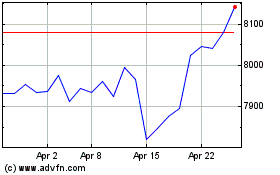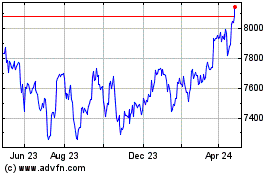LONDON MARKETS: FTSE 100 Rises Sharply From 14-month Low
February 12 2018 - 4:53AM
Dow Jones News
By Victor Reklaitis, MarketWatch
U.K. stock benchmark remains down nearly 5% for the month
U.K. stocks jumped Monday, rallying somewhat alongside a
recovery for U.S. stocks. The move higher came after last week's
global selloff, which handed the FTSE 100 its lowest close since
December 2016.
What are markets doing?
The FTSE 100 gained 1.3% to 7,181.46.
On Friday, the blue-chip gauge had its lowest close since Dec.
23, 2016, as it notched a weekly drop of 4.7%.
Meanwhile, U.S. stock futures were rising
(http://www.marketwatch.com/story/us-stock-futures-climb-point-to-rebound-for-monday-2018-02-12)
Monday, adding to advances seen at the end of last week.
The pound changed hands at $1.3855, up slightly from 1.3830 late
Friday in New York.
What are strategists saying?
"Following the rebound in the U.S. late on Friday and a mixed
session in Asia, European indices are pointing to a stronger start
to the week," said Jasper Lawler, head of research at London
Capital Group, in a note on Monday.
"With commodities rallying across the board and potential for
Brexit-induced weakness in the pound, the FTSE could find itself
leading the charge in the European bourses."
The FTSE 100 is highly sensitive to the pound's swings, as about
75% of revenue for the index's multinational companies is generated
in foreign currencies. It's also a commodities-heavy benchmark, as
it features miners and oil companies.
Brent and West Texas Intermediate crude were both up by more
than 2% on Monday
(http://www.marketwatch.com/story/oil-prices-rebound-after-worst-weekly-loss-in-more-than-a-year-2018-02-12),
recovering amid fresh Mideast tensions after the U.S. benchmark
logged its worst weekly loss in more than a year.
What is driving the market?
U.K. stocks have slumped this month as part of a wider global
market rout. Strategists have pinned the drop in part on the need
for a healthy correction after a runup, as well as on rising bond
yields amid signs of inflation, with the higher yields luring money
out of equities.
See:The Dow's down 10%? It's time for some buying, says longtime
bear Doug Kass
(http://www.marketwatch.com/story/the-dows-down-10-its-time-for-some-buying-says-longtime-bear-doug-kass-2018-02-09)
And read:A U.K. rate rise in May? Analysts digest hawkish
surprise from BOE
(http://www.marketwatch.com/story/a-uk-rate-rise-in-may-analysts-digest-hawkish-surprise-from-boe-2018-02-08)
The FTSE 100 is down 4.7% so far in February, and it's showing a
drop of 1% over the past 12 months.
Which stocks are in focus?
Commodities-related stocks were among the big winners, as oil
rallied and metals prices also saw gains.
Shares in oil giant BP PLC (BP.LN) (BP.LN) tacked on 2.1%, while
rival Royal Dutch Shell PLC's stock (RDSB.LN) added 2%.
Among miners, Glencore PLC (GLEN.LN) and Anglo American PLC
(AAL.LN) gained by 3.6% and 3.7%, respectively.
Barclays PLC (BCS) rose by 1.2% ever after the bank was hit with
a second charge
(http://www.marketwatch.com/story/barclays-faces-2nd-criminal-charge-over-qatar-loan-2018-02-12)
from British authorities over a loan to Middle Eastern
investors.
Off the FTSE 100, Acacia Mining PLC shares (ACA.LN) tumbled 7.4%
after the company said it swung to a pretax loss in the fourth
quarter
(http://www.marketwatch.com/story/acacia-mining-swings-to-loss-on-impairment-charges-2018-02-12),
hurt by an export ban in Tanzania.
(END) Dow Jones Newswires
February 12, 2018 04:38 ET (09:38 GMT)
Copyright (c) 2018 Dow Jones & Company, Inc.
FTSE 100
Index Chart
From Mar 2024 to Apr 2024

FTSE 100
Index Chart
From Apr 2023 to Apr 2024
